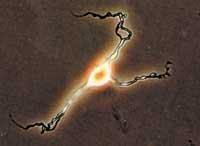Receptor that controls the death of neurons
After stroke many neurons die. The disaster is usually very large and usually irreversible. In order to clarify the cause of death of so many neurons, a receptor that controls the life and death of neurons, called NMDA, is studied.

The function of the NMDA receptor is to regulate the signals, synapses, coming from other neurons. In addition, it helps create new synapses and has to do with the survival of neurons.
It seems that a stroke eliminates a lot of glutamate from the affected cells. Glutamate is an important molecule that participates in synapsis. The moment the molecule reaches other neurons, its NMDA receptors understand it as a signal of cell death, so neurons commit suicide.
In order to explain why a single recipient has such different functions, the University of Washington has launched an investigation that has borne fruit. It seems that the location of NMDA receivers has a lot to do with their later function. NMDA receptors outside the synapse are activated when there is a high glutamate concentration, such as in a heart attack.
And only then do they cause the neuron to die. Inside the sinapsite, on the contrary, the receptors have only regulatory function.





